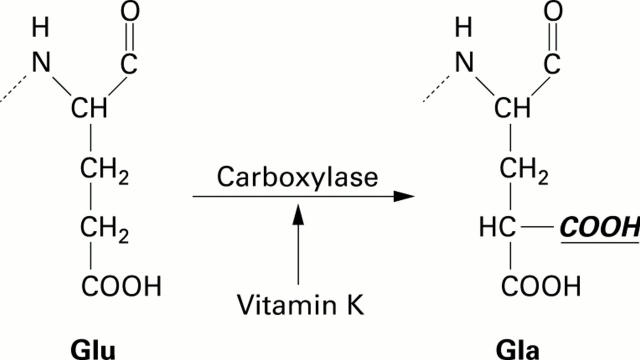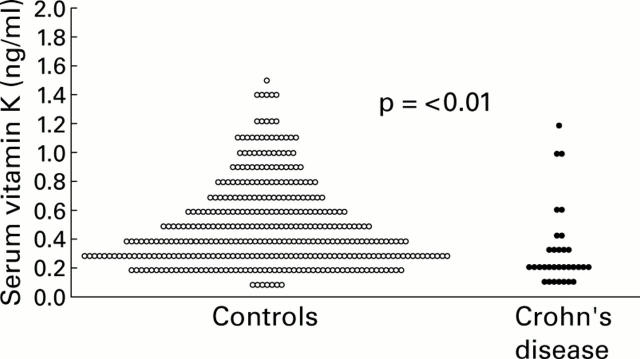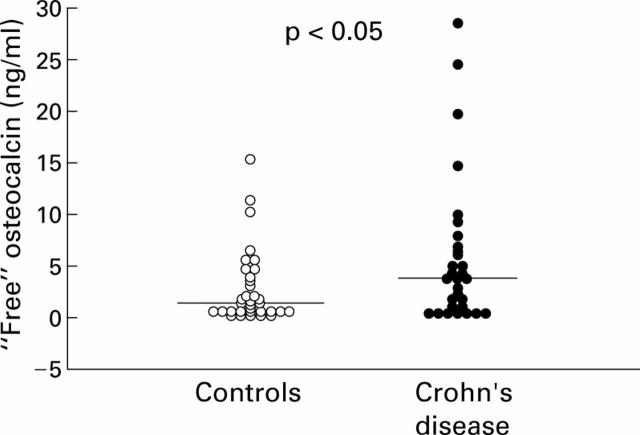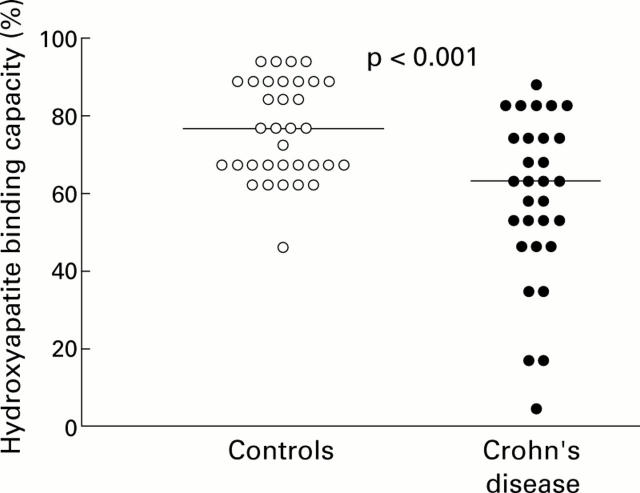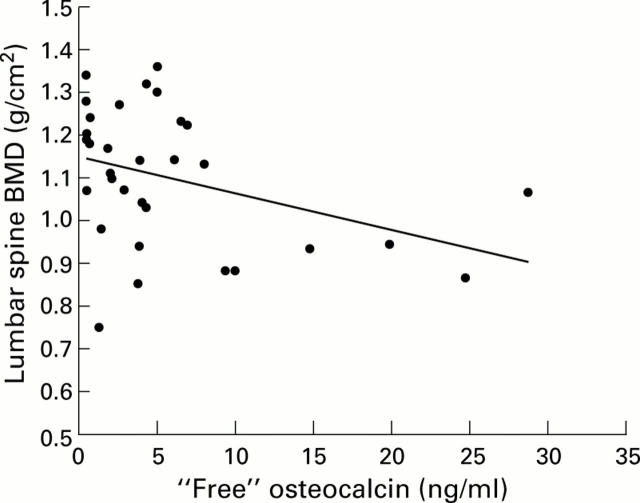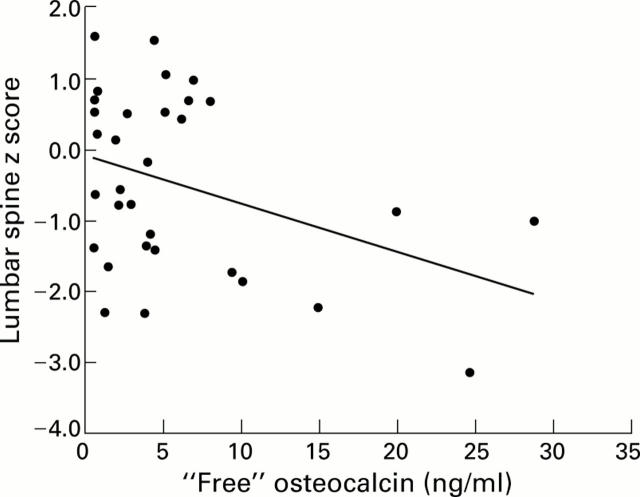Abstract
BACKGROUND—A high prevalence of osteoporosis is reported in Crohn's disease. The pathogenesis is not completely understood but is probably multifactorial. Longstanding Crohn's disease is associated with a deficiency of fat soluble vitamins, among them vitamin K. Vitamin K is a cofactor in the carboxylation of osteocalcin, a protein essential for calcium binding to bone. A high level of circulating uncarboxylated osteocalcin is a sensitive marker of vitamin K deficiency. AIMS—To determine serum and bone vitamin K status in patients with Crohn's disease and to elucidate its relationship with bone mineral density. METHODS—Bone mineral density was measured in 32 patients with longstanding Crohn's disease and small bowel involvement, currently in remission, and receiving less than 5 mg of prednisolone daily. Serum levels of vitamins D and K, triglycerides, and total immunoreactive osteocalcin, as well as uncarboxylated osteocalcin ("free" osteocalcin) were determined. The hydroxyapatite binding capacity of osteocalcin was calculated. Data were compared with an age and sex matched control population. RESULTS—Serum vitamin K levels of CD patients were significantly decreased compared with normal controls (p<0.01). "Free" osteocalcin was higher and hydroxyapatite binding capacity of circulating osteocalcin was lower than in matched controls (p<0.05 and p<0.001, respectively), indicating a low bone vitamin K status in Crohn's disease. In patients, an inverse correlation was found between "free" osteocalcin and lumbar spine bone mineral density (r=−0.375, p<0.05) and between "free" osteocalcin and the z score of the lumbar spine (r=−0.381, p<0.05). Multiple linear regression analysis showed that "free" osteocalcin was an independent risk factor for low bone mineral density of the lumbar spine whereas serum vitamin D was not. CONCLUSIONS—The finding that a poor vitamin K status is associated with low bone mineral density in longstanding Crohn's disease may have implications for the prevention and treatment of osteoporosis in this disorder. Keywords: Crohn's disease; bone mineral density; vitamin K; osteocalcin
Full Text
The Full Text of this article is available as a PDF (185.1 KB).
Figure 1 .
Schematic representation of the vitamin K dependent carboxylation reaction. Reduced vitamin K acts as a cofactor in the carboxylation of glutamic acid residues (Glu) into gamma carboxylation acid residues (Gla). These residues render the protein osteocalcin capable of calcium binding to bone.
Figure 2 .
Serum vitamin K concentrations in patients with longstanding Crohn's disease (n=32) compared with healthy controls (n=34). Median for patients with Crohn's disease is 0.402 ng/ml; median for healthy controls is 0.610 ng/ml.
Figure 3 .
Serum concentrations of "free" (uncarboxylated) osteocalcin in patients with longstanding Crohn's disease (n=32) compared with age and sex matched healthy controls (n=34). Lines indicate median values. Median for patients with Crohn's disease is 3.89 ng/ml; median for healthy controls is 1.51 ng/ml.
Figure 4 .
Hydroxyapatite binding capacity in patients with longstanding Crohn's disease (n=32) compared with age and sex matched healthy controls (n=34). Lines indicate median values. Median for patients with Crohn's disease is 61.71%; median for healthy controls is 76.84%.
Figure 5 .
Correlation between "free" (uncarboxylated) osteocalcin and bone mineral density (BMD) of the lumbar spine in patients with longstanding Crohn's disease (n=32). Correlation coefficient (Pearson's) r=−0.375; p<0.05.
Figure 6 .
Correlation of "free" (uncarboxylated) osteocalcin and bone mineral density z score of the lumbar spine in patients with longstanding Crohn's disease (n=32). Correlation coefficient (Pearson's) r=−0.381; p<0.01.
Selected References
These references are in PubMed. This may not be the complete list of references from this article.
- Abitbol V., Roux C., Chaussade S., Guillemant S., Kolta S., Dougados M., Couturier D., Amor B. Metabolic bone assessment in patients with inflammatory bowel disease. Gastroenterology. 1995 Feb;108(2):417–422. doi: 10.1016/0016-5085(95)90068-3. [DOI] [PubMed] [Google Scholar]
- Andreassen H., Rix M., Brot C., Eskildsen P. Regulators of calcium homeostasis and bone mineral density in patients with Crohn's disease. Scand J Gastroenterol. 1998 Oct;33(10):1087–1093. doi: 10.1080/003655298750026804. [DOI] [PubMed] [Google Scholar]
- Beker L. T., Ahrens R. A., Fink R. J., O'Brien M. E., Davidson K. W., Sokoll L. J., Sadowski J. A. Effect of vitamin K1 supplementation on vitamin K status in cystic fibrosis patients. J Pediatr Gastroenterol Nutr. 1997 May;24(5):512–517. doi: 10.1097/00005176-199705000-00003. [DOI] [PubMed] [Google Scholar]
- Best W. R., Becktel J. M., Singleton J. W., Kern F., Jr Development of a Crohn's disease activity index. National Cooperative Crohn's Disease Study. Gastroenterology. 1976 Mar;70(3):439–444. [PubMed] [Google Scholar]
- Binkley N. C., Suttie J. W. Vitamin K nutrition and osteoporosis. J Nutr. 1995 Jul;125(7):1812–1821. doi: 10.1093/jn/125.7.1812. [DOI] [PubMed] [Google Scholar]
- Bjarnason I., Macpherson A., Mackintosh C., Buxton-Thomas M., Forgacs I., Moniz C. Reduced bone density in patients with inflammatory bowel disease. Gut. 1997 Feb;40(2):228–233. doi: 10.1136/gut.40.2.228. [DOI] [PMC free article] [PubMed] [Google Scholar]
- Caraballo P. J., Heit J. A., Atkinson E. J., Silverstein M. D., O'Fallon W. M., Castro M. R., Melton L. J., 3rd Long-term use of oral anticoagulants and the risk of fracture. Arch Intern Med. 1999 Aug 9;159(15):1750–1756. doi: 10.1001/archinte.159.15.1750. [DOI] [PubMed] [Google Scholar]
- Compston J. E., Judd D., Crawley E. O., Evans W. D., Evans C., Church H. A., Reid E. M., Rhodes J. Osteoporosis in patients with inflammatory bowel disease. Gut. 1987 Apr;28(4):410–415. doi: 10.1136/gut.28.4.410. [DOI] [PMC free article] [PubMed] [Google Scholar]
- Driscoll R. H., Jr, Meredith S. C., Sitrin M., Rosenberg I. H. Vitamin D deficiency and bone disease in patients with Crohn's disease. Gastroenterology. 1982 Dec;83(6):1252–1258. [PubMed] [Google Scholar]
- Ferland G., Sadowski J. A., O'Brien M. E. Dietary induced subclinical vitamin K deficiency in normal human subjects. J Clin Invest. 1993 Apr;91(4):1761–1768. doi: 10.1172/JCI116386. [DOI] [PMC free article] [PubMed] [Google Scholar]
- Geerling B. J., Badart-Smook A., Stockbrügger R. W., Brummer R. J. Comprehensive nutritional status in patients with long-standing Crohn disease currently in remission. Am J Clin Nutr. 1998 May;67(5):919–926. doi: 10.1093/ajcn/67.5.919. [DOI] [PubMed] [Google Scholar]
- Ghosh S., Cowen S., Hannan W. J., Ferguson A. Low bone mineral density in Crohn's disease, but not in ulcerative colitis, at diagnosis. Gastroenterology. 1994 Oct;107(4):1031–1039. doi: 10.1016/0016-5085(94)90227-5. [DOI] [PubMed] [Google Scholar]
- Hara K., Akiyama Y., Ohkawa I., Tajima T. Effects of menatetrenone on prednisolone-induced bone loss in rats. Bone. 1993 Nov-Dec;14(6):813–818. doi: 10.1016/8756-3282(93)90309-x. [DOI] [PubMed] [Google Scholar]
- Hessov I., Mosekilde L., Melsen F., Fasth S., Hultén L., Lund B., Lund B., Sørensen O. H. Osteopenia with normal vitamin D metabolites after small-bowel resection for Crohn's disease. Scand J Gastroenterol. 1984 Jul;19(5):691–696. [PubMed] [Google Scholar]
- Hollis B. W., Kamerud J. Q., Selvaag S. R., Lorenz J. D., Napoli J. L. Determination of vitamin D status by radioimmunoassay with an 125I-labeled tracer. Clin Chem. 1993 Mar;39(3):529–533. [PubMed] [Google Scholar]
- Jahnsen J., Falch J. A., Aadland E., Mowinckel P. Bone mineral density is reduced in patients with Crohn's disease but not in patients with ulcerative colitis: a population based study. Gut. 1997 Mar;40(3):313–319. doi: 10.1136/gut.40.3.313. [DOI] [PMC free article] [PubMed] [Google Scholar]
- Knapen M. H., Eisenwiener H. G., Vermeer C. Osteocalcin detection in aging serum and whole blood: stability of different osteocalcin fractions. Clin Chim Acta. 1996 Dec 30;256(2):151–164. doi: 10.1016/s0009-8981(96)06418-2. [DOI] [PubMed] [Google Scholar]
- Knapen M. H., Nieuwenhuijzen Kruseman A. C., Wouters R. S., Vermeer C. Correlation of serum osteocalcin fractions with bone mineral density in women during the first 10 years after menopause. Calcif Tissue Int. 1998 Nov;63(5):375–379. doi: 10.1007/s002239900543. [DOI] [PubMed] [Google Scholar]
- Krasinski S. D., Russell R. M., Furie B. C., Kruger S. F., Jacques P. F., Furie B. The prevalence of vitamin K deficiency in chronic gastrointestinal disorders. Am J Clin Nutr. 1985 Mar;41(3):639–643. doi: 10.1093/ajcn/41.3.639. [DOI] [PubMed] [Google Scholar]
- Lennard-Jones J. E. Classification of inflammatory bowel disease. Scand J Gastroenterol Suppl. 1989;170:2–19. doi: 10.3109/00365528909091339. [DOI] [PubMed] [Google Scholar]
- Mazess R. B., Barden H. S., Bisek J. P., Hanson J. Dual-energy x-ray absorptiometry for total-body and regional bone-mineral and soft-tissue composition. Am J Clin Nutr. 1990 Jun;51(6):1106–1112. doi: 10.1093/ajcn/51.6.1106. [DOI] [PubMed] [Google Scholar]
- Pigot F., Roux C., Chaussade S., Hardelin D., Pelleter O., Du Puy Montbrun T., Listrat V., Dougados M., Couturier D., Amor B. Low bone mineral density in patients with inflammatory bowel disease. Dig Dis Sci. 1992 Sep;37(9):1396–1403. doi: 10.1007/BF01296010. [DOI] [PubMed] [Google Scholar]
- Robinson R. J., Iqbal S. J., Al-Azzawi F., Abrams K., Mayberry J. F. Sex hormone status and bone metabolism in men with Crohn's disease. Aliment Pharmacol Ther. 1998 Jan;12(1):21–25. doi: 10.1046/j.1365-2036.1998.00271.x. [DOI] [PubMed] [Google Scholar]
- Robinson R. J., al-Azzawi F., Iqbal S. J., Kryswcki T., Almond L., Abrams K., Mayberry J. F. Osteoporosis and determinants of bone density in patients with Crohn's disease. Dig Dis Sci. 1998 Nov;43(11):2500–2506. doi: 10.1023/a:1026650719552. [DOI] [PubMed] [Google Scholar]
- Rucker R. B. Improved functional endpoints for use in vitamin K assessment: important implications for bone disease. Am J Clin Nutr. 1997 Mar;65(3):883–884. doi: 10.1093/ajcn/65.3.883. [DOI] [PubMed] [Google Scholar]
- Sato Y., Honda Y., Kuno H., Oizumi K. Menatetrenone ameliorates osteopenia in disuse-affected limbs of vitamin D- and K-deficient stroke patients. Bone. 1998 Sep;23(3):291–296. doi: 10.1016/s8756-3282(98)00108-2. [DOI] [PubMed] [Google Scholar]
- Shiraki M., Shiraki Y., Aoki C., Miura M. Vitamin K2 (menatetrenone) effectively prevents fractures and sustains lumbar bone mineral density in osteoporosis. J Bone Miner Res. 2000 Mar;15(3):515–521. doi: 10.1359/jbmr.2000.15.3.515. [DOI] [PubMed] [Google Scholar]
- Silvennoinen J. A., Karttunen T. J., Niemelä S. E., Manelius J. J., Lehtola J. K. A controlled study of bone mineral density in patients with inflammatory bowel disease. Gut. 1995 Jul;37(1):71–76. doi: 10.1136/gut.37.1.71. [DOI] [PMC free article] [PubMed] [Google Scholar]
- Silvennoinen J. Relationships between vitamin D, parathyroid hormone and bone mineral density in inflammatory bowel disease. J Intern Med. 1996 Feb;239(2):131–137. doi: 10.1046/j.1365-2796.1996.420765000.x. [DOI] [PubMed] [Google Scholar]
- Tromm A., Rickels K., Hüppe D., Wiebe V., May B. Osteopenie bei chronisch entzündlichen Darmerkrankungen. Ergebnisse einer Querschnittsuntersuchung mittels quantitativer Computertomographie. Leber Magen Darm. 1994 Feb;24(1):23-6, 29-30. [PubMed] [Google Scholar]
- Vermeer C. Gamma-carboxyglutamate-containing proteins and the vitamin K-dependent carboxylase. Biochem J. 1990 Mar 15;266(3):625–636. doi: 10.1042/bj2660625. [DOI] [PMC free article] [PubMed] [Google Scholar]
- Vermeer C., Jie K. S., Knapen M. H. Role of vitamin K in bone metabolism. Annu Rev Nutr. 1995;15:1–22. doi: 10.1146/annurev.nu.15.070195.000245. [DOI] [PubMed] [Google Scholar]
- Vogelsang H., Ferenci P., Woloszczuk W., Resch H., Herold C., Frotz S., Gangl A. Bone disease in vitamin D-deficient patients with Crohn's disease. Dig Dis Sci. 1989 Jul;34(7):1094–1099. doi: 10.1007/BF01536381. [DOI] [PubMed] [Google Scholar]



